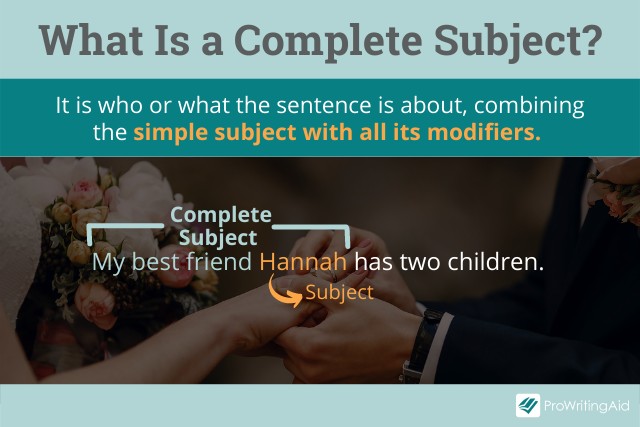Every well-formed sentence hinges on two fundamental parts: the subject and the predicate. Delving deeper, we encounter the concept of a complete subject, which expands upon the simple subject by incorporating modifiers and descriptive elements. This article aims to provide a comprehensive understanding of what constitutes a complete subject, complete with illustrative examples to solidify your grasp of this grammatical concept.
Defining the Complete Subject
To fully appreciate the complete subject, it’s crucial to differentiate it from its simpler counterpart and understand its relationship with the predicate.
The subject is the noun or pronoun that performs the action or is being described in the sentence. The predicate contains the verb and tells us what the subject does or is.
Subjects can be categorized into two types: simple and complete.
A simple subject is the core noun or pronoun that identifies who or what the sentence is about. It’s stripped of any descriptive details.
A complete subject, conversely, encompasses the simple subject along with all its modifiers. Modifiers are words, phrases, or clauses that add information about the subject. These can include articles (a, an, the), adjectives (describing words), adverbs (modifying verbs, adjectives, or other adverbs), prepositional phrases, and even entire clauses.
Consider the following example:
- The old, rusty bicycle sat in the shed.
In this sentence, the simple subject is “bicycle.” However, the complete subject is “The old, rusty bicycle,” as it includes the article “The” and the adjectives “old” and “rusty,” all of which modify and provide more detail about the bicycle.
Dissecting the Components of a Complete Subject
Complete subjects typically appear at the beginning of a sentence, but exceptions do occur, particularly in sentences employing inverted sentence structure or questions.
Identifying the complete subject requires a methodical approach:
- Locate the Verb: Find the verb in the sentence. This will help isolate the predicate.
- Identify the Simple Subject: Ask yourself, “Who or what is performing the action (verb)?” or “Who or what is the sentence about?” The answer will be your simple subject.
- Expand to the Complete Subject: Include all words, phrases, or clauses that modify or describe the simple subject.
Let’s apply this to a more complex example:
-
The tall, mysterious woman with the piercing blue eyes walked into the room.
- Verb: walked
- Simple Subject: woman
- Complete Subject: The tall, mysterious woman with the piercing blue eyes
Notice how the complete subject incorporates the article “The,” adjectives “tall” and “mysterious,” and the prepositional phrase “with the piercing blue eyes,” all providing additional information about the woman.
Compound Subjects and Complete Subjects
A compound subject consists of two or more simple subjects joined by a conjunction (such as “and” or “or”) that share the same verb. When dealing with compound subjects, the complete subject includes all the simple subjects and their respective modifiers.
For instance:
-
The playful golden retriever and the grumpy old cat nap peacefully in the sun.
- Verb: nap
- Simple Subjects: retriever, cat
- Complete Subject: The playful golden retriever and the grumpy old cat
Complete Subject Examples
Here are some more examples to help you practice identifying complete subjects:
- My neighbor’s ancient, sputtering car finally broke down.
- The students who studied diligently for the exam passed with flying colors.
- The small, cozy cabin by the lake is the perfect weekend getaway.
- Running quickly in the park, the happy dog chased after the frisbee.
In each of these examples, the bolded portion represents the complete subject, encompassing the simple subject and all its modifiers.
Understanding the complete subject is crucial for analyzing sentence structure and improving your writing. By mastering this concept, you can construct clearer, more descriptive, and grammatically sound sentences.

